Bicarbonate ion hco3 Study guides, Class notes & Summaries
Looking for the best study guides, study notes and summaries about Bicarbonate ion hco3? On this page you'll find 601 study documents about Bicarbonate ion hco3.
Page 3 out of 601 results
Sort by
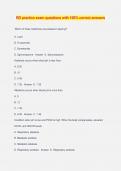
-
RD practice exam questions with 100% correct answers
- Exam (elaborations) • 33 pages • 2024
- Available in package deal
-
- $13.49
- + learn more
RD practice exam questions with 100% correct answers Which of these medicines are potassium sparing? A. Lasix B. Furosemide C. Bumetanide D. Spironolactone - Answer- D. Spironolactone Acidemia occurs when blood pH is less than: A. 8.35 B. 10 C. 6.45 D. 7.35 - Answer- D. 7.35 Alkalemia occurs when blood pH is more than: A. 5 B. 12 C. 7.45 D. 8.45 - Answer- C. 7.45 Condition when pH is low and PCO2 is high. When the body compensates, elevated HCO3- and H2CO3 levels. A. Respirator...
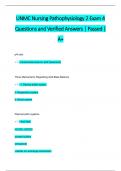
-
UNMC Nursing Pathophysiology 2 Exam 4 Questions and Verified Answers | Passed | A+
- Exam (elaborations) • 26 pages • 2024
- Available in package deal
-
- $12.99
- + learn more
pH ratio : bicarbonate/carbonic acid (base/acid) Three Mechanisms Regulating Acid-Base Balance : 1. Plasma buffer system 2. Respiratory system 3. Renal system Plasma buffer systems : work fast! -HCO3-, H2CO3 -protein buffers -phosphate -cellular ion exchange mechanism 2 How does the respiratory system regulate acid-base balance? : Regulate retention or elimination of CO2 through changes in rate of ventilation. How does the renal system regulate acid-base balance? : kidneys eith...
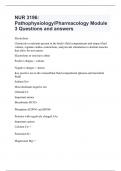
-
NUR 3196: Pathophysiology/Pharmacology Module 3 Questions and answers
- Exam (elaborations) • 20 pages • 2024
-
Available in package deal
-
- $12.99
- + learn more
Electrolytes Chemicals or nutrients present in the body's fluid compartments and impact fluid volume, regulate cardiac contractions, and provide stimulation to skeletal muscles that allow for movement. Electrolytes or ions have either Positive charges = cations Negative charges = anions Key positive ion in the extracellular fluid compartment (plasma and interstitial fluid) Sodium Na+ Most dominant negative ion Chloride Cl- Important anions Bicarbonate HCO3- Phosphates H2PO4- and ...
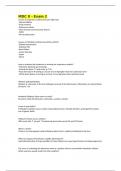
-
MDC II - Exam 2 |Complete Questions With Correct Answers
- Exam (elaborations) • 8 pages • 2024
-
Available in package deal
-
- $10.49
- + learn more
MDC II - Exam 2 Causes of respiratory acidosis (low ph/ high CO2) -Hypoventilation -Drug overdose -Pulmonary edema -Chest trauma/neuromuscular disease -COPD -Airway obstruction Causes of Metabolic Acidosis (low pH/low HCO3) -Diabetic ketoacidosis -Salicylate OD -Renal failure -Severe diarrhea -Sepsis -Shock How to evaluate that treatment is working for respiratory acidosis? -Maintains adequate gas exchange -Arterial pH above 7.2 and closer to 7.35 -PaO2 level above 90 m...

-
TEAS 7 Question and answers correctly solved
- Exam (elaborations) • 11 pages • 2024
-
Available in package deal
-
- $14.49
- + learn more
TEAS 7 Question and answers correctly solved Which of the following is the process by what DNA is copied into RNA transcription carbon has an atomic number of 6. what is true about isotope c-12 c-12 possesses 6 neutrons and 6protons in its. nucleus 1. Which of the following best describes adaptive immunity? o The body's barrier defences, such as mucous membranes and secretions o The initiation of internal defences, such as phagocytes and natural killer cells o The initiation of t...
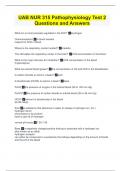
-
UAB NUR 315 Pathophysiology Test 2 Questions and Answers
- Exam (elaborations) • 9 pages • 2024
-
Available in package deal
-
- $9.99
- + learn more
What ion is most precisely regulated in the ECF? Hydrogen Chemoreceptors in blood vessels respond to CO2 in blood Where is the respiratory center located? medulla The stimulates the respiratory center in the brain? CO2 accumulation in the blood What is the major stimulus for inhalation? CO2 concentration in the blood (hypercapnia) What are arterial blood gases? the concentration of O2 and CO2 in the bloodstream Is carbon dioxide an acid or a base? acid Is bicarbonate (HCO3) an acid or a b...
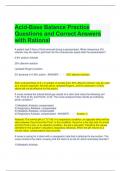
-
Acid-Base Balance Practice Questions and Correct Answers with Rational
- Exam (elaborations) • 59 pages • 2023
-
- $19.49
- + learn more
Acid-Base Balance Practice Questions and Correct Answers with Rational A patient had 5 liters of fluid removed during a paracentesis. What intravenous (IV) solution may be used to pull fluid into the intravascular space after the paracentesis? 0.9% sodium chloride 25% albumin solution Lactated Ringer's solution 5% dextrose in 0.45% saline - ANSWER 25% albumin solution After a paracentesis of 5 L or greater of ascites fluid, 25% albumin solution may be used as a ...
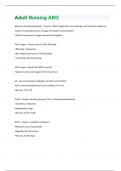
-
Adult Nursing ABG Exam All Possible Questions and Answers with complete solution
- Exam (elaborations) • 5 pages • 2024
- Available in package deal
-
- $7.99
- + learn more
What are arterial blood gases? - Answer--reflect oxygenation, gas exchange, and acid-base imbalance -PaO2 is the partial pressure of oxygen dissolved in arterial blood -SaO2 is the amount of oxygen bound to hemoglobin PaO2 ranges - Answer-normal is 80-100mmHg <80mmHg = hypoxemia <60 mmHg may be seen in COPD patients < 40 mmHg is life threatening SaO2 ranges - Answer-93-100% is normal -hypoxia is decreased oxygen at the tissue level pH - Answer-•Measures hydrogen ion (H+) conc...
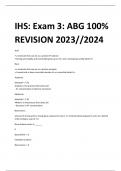
-
IHS: Exam 3: ABG 100% REVISION 2023//2024
- Exam (elaborations) • 13 pages • 2023
-
- $12.49
- + learn more
IHS: Exam 3: ABG 100% REVISION 2023//2024 Acid • a molecule that can act as a proton (H+) donor. • Strong acid readily and irreversible gives up an H+, and a strong base avidly binds H+ Base • a molecule that can act as a proton acceptor. • A weak acid or base reversible donates H+ or reversible binds H+. Acidemia blood pH < 7.35 Acidosis is the process that lowers pH - H+ concentration in blood is increased Alkalemia blood pH > 7.45 Alkalosis is the process that rai...
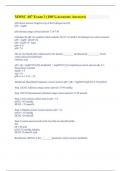
-
MMSC 407 Exam 3 (100%Accurate Answers)
- Exam (elaborations) • 9 pages • 2023
-
Available in package deal
-
- $10.39
- + learn more
pH correct answers Negative log of the hydrogen activity pH = -logH+ pH reference range correct answers 7.35-7.45 Calculate the pH of a solution which contains 4X 10^-8 mmol/L of hydrogen ion correct answers pH = -logH+ (4X10^-8) pH= -log10^-8 - log4 pH= 8-.6 pH= 7.4 The in vivo blood pH is influenced by the plasma ________ and dissolved _____ ____ levels correct answers bicarbonate carbonic acid pH = pk + logHCO3 [(20) metabolic] + logH2CO3 [(1) respiratory] correct answers ...

How did he do that? By selling his study resources on Stuvia. Try it yourself! Discover all about earning on Stuvia


